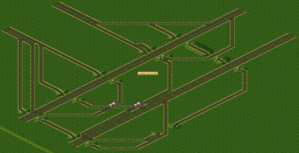Backbone Hub
From #openttdcoop wiki
A backbone hub (BBH) is the largest type of Hub that is built in #OpenTTDCoop. It usually consists of at least 3 cardinal directions of mainline Track, and is also usually balanced as well.
Recommended blog post: Advanced building revue 06 - Hubs
Function
A BBH connects mainline segments to each other, most often in 4-way or 3-way junction patterns.
Requirements
A BBH must be:
- Balanced - ie: each lane entering the BBH should be able to choose any lane leaving the BBH
- Efficient - Trains should not have to slow down
- Properly sized for the highest length trains in use
Backbone Hub Building
Backbone hubs are complex structures and can be quite overwhelming at first. In this article I'll try to break down backbone hub construction in pieces in an attempt to make it easier to understand and give an idea on how to start. Note that this article does expect at least basic knowledge about pre-signalling and knows the #openttdcoop building standards, including doubled bridges, non-slowing down curves and balancing.
The BBH we're going to build here will be an LL5RR to LL5RR 3-way one. These are quite common and relatively easy to build. Below you can see the mainlines that are already in place, waiting for the BBH to be built.
A typical 3-way can be broken down into pieces; one ML crossing, one crossover, 3 exits and 3 joins. You'll want to start with the ML crossing, this is where the ML crosses an other ML. It is a common mistake to start with an exit or a join; don't do this. The ML crossing will be in the center of the hub, making it hard to add later. The crossover is the point where the joining mainline cross each other, you will one or more of these in every BBH because they are needed to allow traffic to go to the other direction. In the image below the ML crossing and crossover are built. Also the locations for the joins and exits are signed, giving a general idea about the layout we'll have in the end. The first exit obviously was built together with the crossover.
Now let's make the other 2 exits, this should be pretty straightforward as exits don't require balancing.
Up next are the joins; these are harder than exits because they require balancing. At this point you can already see we won't have to worry about space limitations because we started building outwards from the center. Below shows our BBH with full-balanced non-blocking all-to-all joining.
The only thing left to do is finishing the signaling and adding priorities to our balancers. Note that you can hack in priorities in any place, so you don't have to worry about reserving space for them.
Additional BBH Building Guides
BBH come is all shapes and sizes, depending on the map and intention of the design. Alternatives including a Pivot BBH where traffic rotates around a pivot with entrances and exists.






